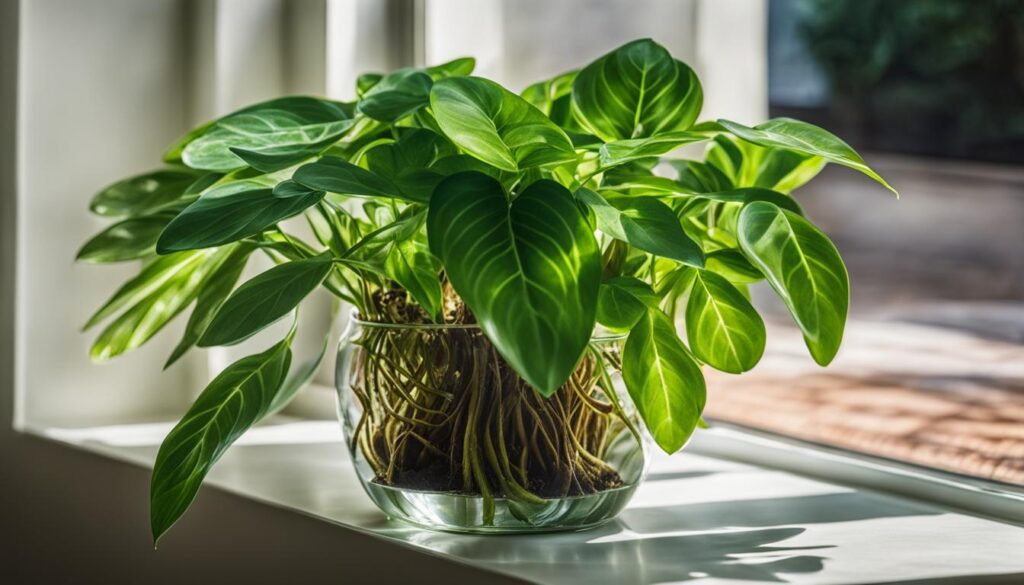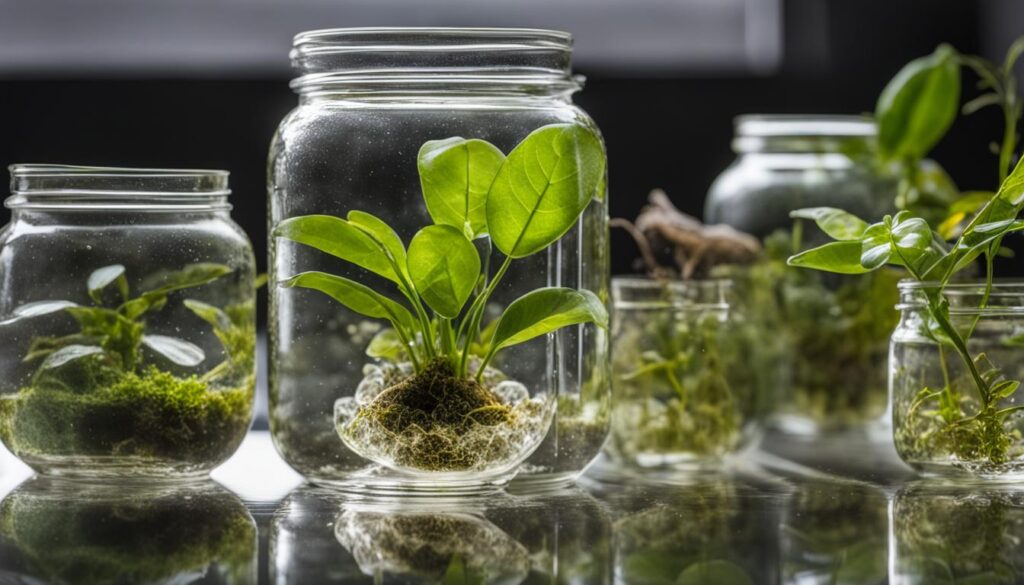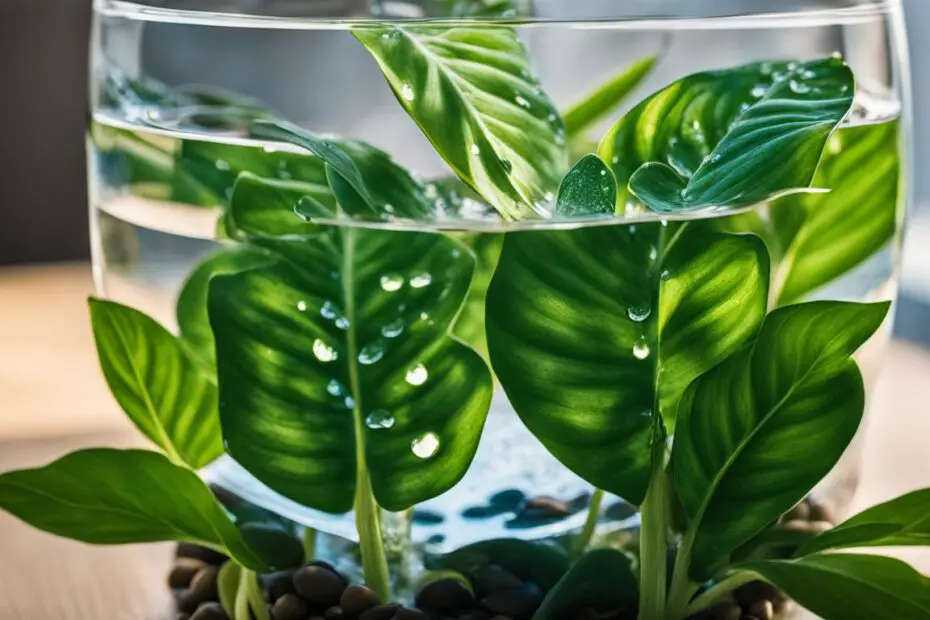Prayer plants are beloved for their stunning foliage and unique patterns, making them a popular choice among indoor plant enthusiasts. If you’re wondering whether these beautiful plants can grow in water, you’re in the right place. In this comprehensive guide, we’ll explore the process of water propagation for prayer plants, the benefits of this method, and provide step-by-step instructions on how to grow prayer plants in water. Whether you’re a seasoned plant parent or a beginner, this guide will equip you with the knowledge to successfully propagate and care for prayer plants through water propagation.
Key Takeaways:
- Prayer plants can be propagated through water propagation, which involves cutting a stem and placing it in water.
- Water propagation offers benefits such as the ability to observe root growth and the option for hydroponic growth without soil.
- To successfully propagate prayer plants in water, ensure proper care, including transitioning the plant to soil and providing suitable lighting and watering practices.
- Other methods of propagating prayer plants include division and propagation in soil.
- Growing prayer plants from seeds can be more challenging, as they rarely bloom flowers necessary for seed production.
The Process of Water Propagation for Prayer Plants
Water propagation is a popular method for propagating prayer plants. This technique involves cutting a stem just below a node and placing it in a jar with room-temperature water. To ensure successful root growth, it is important to remove any leaves that would be submerged in the water, as they can rot. The jar should be placed in a bright area with indirect sunlight, and covering it with a clear plastic bag creates a greenhouse effect that promotes root development.
Once the roots have developed, it is time to transfer the plant to a pot with moistened soil. The water-propagated prayer plant should be carefully removed from the jar, and any excess water should be gently shaken off. The plant can then be planted in a suitable pot filled with moist soil. It is crucial to provide regular watering and appropriate care to ensure the growth and health of the propagated plant.
| Steps for Water Propagation of Prayer Plants |
|---|
| Cut a stem below a node using clean scissors |
| Remove any leaves below the water’s surface to prevent rot |
| Submerge the node in a jar with room-temperature water |
| Place the jar in a bright area with indirect sunlight |
| Cover the jar with a clear plastic bag to create a greenhouse effect |
| Transfer the plant to a pot with moistened soil once roots have developed |
| Water the plant regularly and provide appropriate care |
Water propagation can be a rewarding and effective method for growing new prayer plants. It allows you to witness the roots developing and provides a fascinating process to observe. By following the steps outlined above and providing proper care, you can successfully propagate prayer plants in water and enjoy the beauty of these unique indoor plants.
Benefits of Water Propagation for Prayer Plants:
Water propagation for prayer plants offers several benefits. It allows you to observe root growth, which can be a fascinating experience for plant enthusiasts. Additionally, water propagation can serve as a form of hydroponics for prayer plants, enabling them to grow without the need for soil. This method also allows you to create new plants from mature prayer plants, expanding your collection with ease. With its simplicity and practicality, water propagation is a popular technique among plant lovers.
The Benefits of Water Propagation for Prayer Plants
Water propagation offers several benefits for prayer plants. It allows you to observe the roots growing, which can be a fascinating process. Additionally, water propagation can be a form of hydroponics for prayer plants, as they can grow in water without the need for soil. This method of propagation can also be used to create new plants from mature prayer plants. It is a simple and practical technique that can be easily implemented by plant enthusiasts.

“Water propagation allows us to witness the intricate development of prayer plant roots,” says horticulturist Jane Smith.
“By eliminating the need for soil, water propagation transforms prayer plants into hydroponic wonders. This method is not only efficient but also sustainable, as it reduces the need for potting soil and minimizes waste.”
Whether you’re a beginner or an experienced plant grower, water propagation can be a rewarding way to expand your prayer plant collection and explore the wonders of hydroponics.
Enhancing Plant Health
Water propagation provides an environment that promotes healthy root development. The absence of soil eliminates the risk of overwatering, which can lead to root rot. Additionally, monitoring the water quality becomes easier, ensuring that the propagated plants receive the essential nutrients they need to thrive. This method also minimizes the risk of pests and diseases often associated with soil-based propagation.
Creating New Plants
Water propagation is a dynamic way to create new prayer plants from existing ones. By selecting healthy stems and providing them with the right water and light conditions, you can propagate several plants simultaneously. This not only allows you to grow your collection but also gives you the opportunity to share the joy of prayer plants with fellow plant enthusiasts.
Experimenting with Different Techniques
Water propagation opens doors to creativity and experimentation. You can explore various methods and setups, such as using clear containers for better visibility of root growth or adding liquid fertilizers to enhance plant nutrition. This process enables you to customize and refine your water propagation techniques to suit the specific needs of your prayer plants.
| Aspect | Soil Propagation | Water Propagation |
|---|---|---|
| Root Development | Roots develop in soil | Roots develop in water |
| Watering Requirements | Regular watering | Water levels need to be checked and maintained |
| Susceptibility to Root Rot | Potential risk due to overwatering | Eliminated risk as overwatering is reduced |
| Customization | Soil types can be chosen | Experimentation with containers and liquid fertilizers |
Table: A comparison of soil propagation and water propagation for prayer plants.
Steps for Water Propagation of Prayer Plants
Water propagation is a simple and effective method for propagating prayer plants. By following these steps, you can successfully grow new plants from cuttings:
- Start by selecting a healthy prayer plant and sterilizing a pair of clean scissors.
- Cut a stem just below a node, ensuring that the cutting is about 4-6 inches long.
- Remove any leaves that would be submerged in water, as they can rot.
- Place the cutting in a jar filled with room-temperature water, making sure that the node is submerged.
- Position the jar in a bright area with indirect sunlight to promote root growth.
- Cover the jar with a clear plastic bag to create a greenhouse effect and maintain humidity.
- Monitor the water level and change it regularly to prevent stagnation.
- After a few weeks, roots will begin to develop. Once the roots are at least an inch long, carefully transfer the cutting into a pot with moistened soil.
- Continue to care for the newly propagated prayer plant by watering it regularly, providing ample indirect sunlight, and ensuring the soil stays moist but not waterlogged.
Following these steps will help you successfully propagate prayer plants in water and expand your indoor garden. Remember to be patient and provide proper care for the propagated plants to ensure their healthy growth.
Tips for Successful Water Propagation
- Choose a healthy prayer plant with strong stems and vibrant foliage for the best chances of success.
- Use clean, sterilized scissors to avoid introducing any diseases or pests to the cutting.
- Ensure that the node is fully submerged in water to encourage root development.
- Keep the water level consistent and change it regularly to prevent the growth of algae or bacteria.
- Place the jar in a warm and bright area with indirect sunlight, as prayer plants thrive in these conditions.
- Monitor the progress of the roots and transfer the cutting to soil once they are well-established.
- Provide proper care for the newly propagated plant, including regular watering and appropriate lighting.
By following these tips, you can increase the success rate of water propagation for your prayer plants and enjoy the satisfaction of growing new plants from cuttings.
Now that you have learned the steps and tips for water propagation, you can confidently propagate prayer plants in water and expand your collection of these beautiful and versatile plants.
The Importance of Care for Water-Propagated Prayer Plants
While water propagation can be an effective method for growing prayer plants, it is crucial to provide them with proper care to ensure their development and well-being. Water-rooted prayer plants may require a gradual transition from water to soil as they adjust to the new growing medium. One key aspect of care is to make sure that the pot has drainage holes to prevent waterlogging, which can lead to root rot. It’s essential to monitor the moisture level of the soil and water the plant regularly, but avoid overwatering.
Placing the water-propagated prayer plant in a bright area with indirect sunlight is also important. Prayer plants thrive in medium to bright light conditions, and exposing them to direct sunlight can cause leaf burn. Providing sufficient light is crucial for their growth and overall health. Additionally, maintaining proper humidity levels is beneficial for water-propagated prayer plants, as they prefer a moderately humid environment. Consider placing a humidity tray or using a humidifier to create the ideal conditions for their growth.
With the right care and attention, water-propagated prayer plants can thrive and continue to flourish. Transitioning the plant to soil, monitoring moisture levels, providing appropriate lighting, and maintaining humidity are essential factors to consider in the care of these beautiful plants. By providing them with the necessary conditions for growth, you can enjoy the beauty of prayer plants in your indoor space.

Key Points:
- Gradually transition water-propagated prayer plants to soil.
- Ensure the pot has drainage holes to prevent root rot.
- Monitor soil moisture and avoid overwatering.
- Place the plant in a bright area with indirect sunlight.
- Provide medium to high humidity levels for optimal growth.
Other Methods of Propagating Prayer Plants
In addition to water propagation, there are other methods that can be used to propagate prayer plants. These methods include propagation by division and propagation in soil. Each method has its own advantages and can be effective depending on your preferences and circumstances.
Propagation by Division
Propagation by division involves separating sections of the mother plant and planting them individually in separate pots. To propagate prayer plants using this method, gently remove the original plant from its pot and carefully loosen the soil around the roots. Look for any loose stems that can be cut and planted separately. Plant each section in a pot with moistened soil and provide appropriate care for their growth.
Propagation in Soil
Propagation in soil is another method that can be used to propagate prayer plants. To propagate using this method, take stem cuttings from the mother plant and place them directly into a container with moistened soil. Make sure the cuttings have a node and are buried deep enough in the soil for proper root formation. Water the cuttings regularly and provide them with the necessary care to promote growth.
By using these alternative methods of propagation, you can expand your collection of prayer plants and enjoy the process of nurturing new plants. Experiment with different methods to find which one works best for you and your plants.

Growing Prayer Plants from Seeds
While it is possible to grow prayer plants from seeds, it can be more challenging compared to other propagation methods. Prayer plants rarely bloom flowers, which are necessary for seed production. If you have a flowering prayer plant and obtain seeds, you can plant them in moistened soil with temperatures between 55℉ to 65℉ (13℃ to 18℃). Cover the soil with a clear plastic bag to maintain moisture, and when the roots have grown long enough, remove the plastic bag and provide the plant with indirect sunlight. Growing prayer plants from seeds requires patience and specific conditions for successful germination and growth.
When growing prayer plants from seeds, it is important to create the ideal environment for germination. Maintain a consistent temperature and humidity level, as fluctuations can affect the seeds’ ability to sprout. It is recommended to use a seed-starting mix or a well-draining soil mixture to ensure proper moisture retention while preventing waterlogging.
“Growing prayer plants from seeds requires patience and specific conditions for successful germination and growth.”
Once the seeds have been planted, be mindful of the watering schedule. Keep the soil consistently moist but not overly saturated. Over-watering can lead to root rot and hinder the growth of the seedlings. Provide the plants with indirect sunlight to encourage healthy and robust growth. As the seedlings develop, gradually expose them to longer periods of direct sunlight to acclimate them to the new environment.
Tips for Successful Prayer Plant Seed Germination:
- Use fresh, viable seeds from a flowering prayer plant
- Provide the seeds with consistent temperature and humidity
- Use a well-draining seed-starting mix or soil mixture
- Keep the soil consistently moist but not waterlogged
- Expose the seedlings to indirect sunlight gradually
By following these tips and providing the necessary care, you can successfully grow prayer plants from seeds. It may require some patience and attention to detail, but the reward of nurturing a seedling into a flourishing plant is well worth the effort.
Best Time and Conditions for Propagating Prayer Plants
When it comes to propagating prayer plants, timing and environmental conditions play a crucial role in the success of the propagation process. Understanding the best time to propagate and providing the right conditions can significantly increase the chances of success.
Timing for Propagation:
The ideal time to propagate prayer plants is during their active growing seasons, which typically occur in the spring and summer. These seasons provide optimal conditions for root development and overall plant growth. However, it is important to note that prayer plants can be propagated at any time of the year, even indoors.
Environmental Conditions:
Creating the right environment for prayer plant propagation is essential. The following conditions should be considered:
- Lighting: Prayer plants thrive in bright, indirect light. Place the propagated plant in a location that receives sufficient light without direct sunlight, as excessive sunlight can damage the leaves.
- Temperature: Maintain a temperature range of 65-75°F (18-24°C) to ensure optimal growth. Avoid exposing the propagated plant to extreme temperature fluctuations, as this can hinder root development.
- Humidity: Prayer plants prefer high humidity levels. Consider using a humidifier or placing the propagated plant near a tray of water to increase the humidity in the surrounding environment.
- Watering: Keep the soil consistently moist but not waterlogged. Overwatering can lead to root rot, while underwatering can hinder root development.
By propagating prayer plants during their active growth seasons and providing the right environmental conditions, you can significantly increase the success rate of propagation. Remember to monitor the plant’s progress and make adjustments as needed to ensure optimal growth and development.

Table: Ideal Conditions for Prayer Plant Propagation
| Aspect | Ideal Condition |
|---|---|
| Lighting | Bright, indirect light |
| Temperature | 65-75°F (18-24°C) |
| Humidity | High humidity levels |
| Watering | Consistently moist, not waterlogged |
Tips for Successful Prayer Plant Propagation
Propagating prayer plants in water can be a rewarding and successful endeavor. To increase your chances of success, here are some tips to keep in mind:
- Choose healthy parent plants: Select prayer plants that are in good health and free from pests or diseases. Healthy parent plants will produce strong and resilient offspring.
- Select the right cutting: When taking a cutting for water propagation, choose a stem that is healthy, with several leaves and a well-developed node. This will give your new plant the best chance of rooting successfully.
- Use clean tools: Before taking any cuttings, make sure your tools are clean and sanitized. This helps prevent the transmission of any harmful pathogens that could affect the cuttings’ ability to root.
- Provide the right environment: Prayer plants thrive in warm and humid conditions. When propagating in water, ensure the jar is placed in a location with indirect sunlight and consistent temperatures between 65-75°F (18-24°C).
- Change the water regularly: To maintain the health of the cutting, change the water every few days. This helps prevent the growth of algae or bacteria that could hinder root development.
- Be patient: Root development in water can take several weeks. It’s important to be patient and resist the urge to disturb the cutting during this time. Allow the roots to develop fully before transferring to soil.
“Propagation in water can be a fascinating process to witness as you observe the growth of roots from a single cutting,” says plant enthusiast Jane Doe. “It’s a rewarding and accessible method for propagating prayer plants, even for beginners.”
Following these tips will help increase the success rate of water propagation for prayer plants. Keep in mind that not all cuttings will root successfully, but with patience and practice, you’ll be able to expand your collection and enjoy the beauty of prayer plants propagated in water.

Conclusion
Prayer plants can indeed grow in water through the process of water propagation. By cutting a stem below a node and placing it in a jar with water, you can create the ideal conditions for root development. Water propagation offers a simple and practical method for growing new prayer plants.
While water propagation can be effective, it is crucial to provide proper care for the propagated plant. This includes transitioning the plant to soil and ensuring suitable lighting and watering practices. By following the steps outlined in this guide and being attentive to the needs of your prayer plants, you can successfully propagate and nurture these beautiful indoor plants.
In summary, prayer plants can grow in water through water propagation. It is a fascinating process that allows you to observe root growth. With the right care and attention, water-propagated prayer plants can thrive and continue to grow. So, if you’re wondering how to grow prayer plants in water, water propagation might just be the answer you’re looking for.
FAQ
Can prayer plants be propagated in water?
Yes, prayer plants can be propagated in water through a process called water propagation.
How do you propagate prayer plants in water?
To propagate prayer plants in water, cut a stem just below a node and place it in a jar with room-temperature water. Keep the node submerged and ensure there are no leaves below the water’s surface. Cover the jar with a clear plastic bag and place it in a bright area with indirect sunlight. Once the roots have developed, transfer the plant to a pot with moistened soil.
What are the benefits of water propagation for prayer plants?
Water propagation allows you to observe root growth and can serve as a form of hydroponics for prayer plants. It is also a simple and practical technique for growing new plants from mature ones.
What are the steps for water propagation of prayer plants?
The steps for water propagation of prayer plants include cutting a stem below a node, placing it in a jar with water, creating a greenhouse effect with a clear plastic bag, and transferring the plant to soil once the roots have developed.
How should water-propagated prayer plants be cared for?
Water-propagated prayer plants should be gradually transitioned from water to soil, provided with proper drainage and moisture in the soil, watered regularly, and placed in a bright area with indirect sunlight.
Are there other methods of propagating prayer plants?
Yes, prayer plants can also be propagated through division and in soil using stem cuttings.
Can prayer plants be grown from seeds?
While it is possible to grow prayer plants from seeds, it can be more challenging due to the rarity of flowers and seed production. Specific conditions and patience are required for successful germination and growth.
What is the best time and conditions for propagating prayer plants?
The best time to propagate prayer plants is during the growing seasons of spring and summer. It is important to consider humidity levels and provide appropriate lighting and a humid environment for successful propagation.
What are some tips for successful prayer plant propagation?
Tips for successful prayer plant propagation include using clean scissors, transitioning water-propagated plants to soil gradually, ensuring proper drainage and moisture in the soil, providing adequate lighting, and monitoring the plant’s growth and care.








